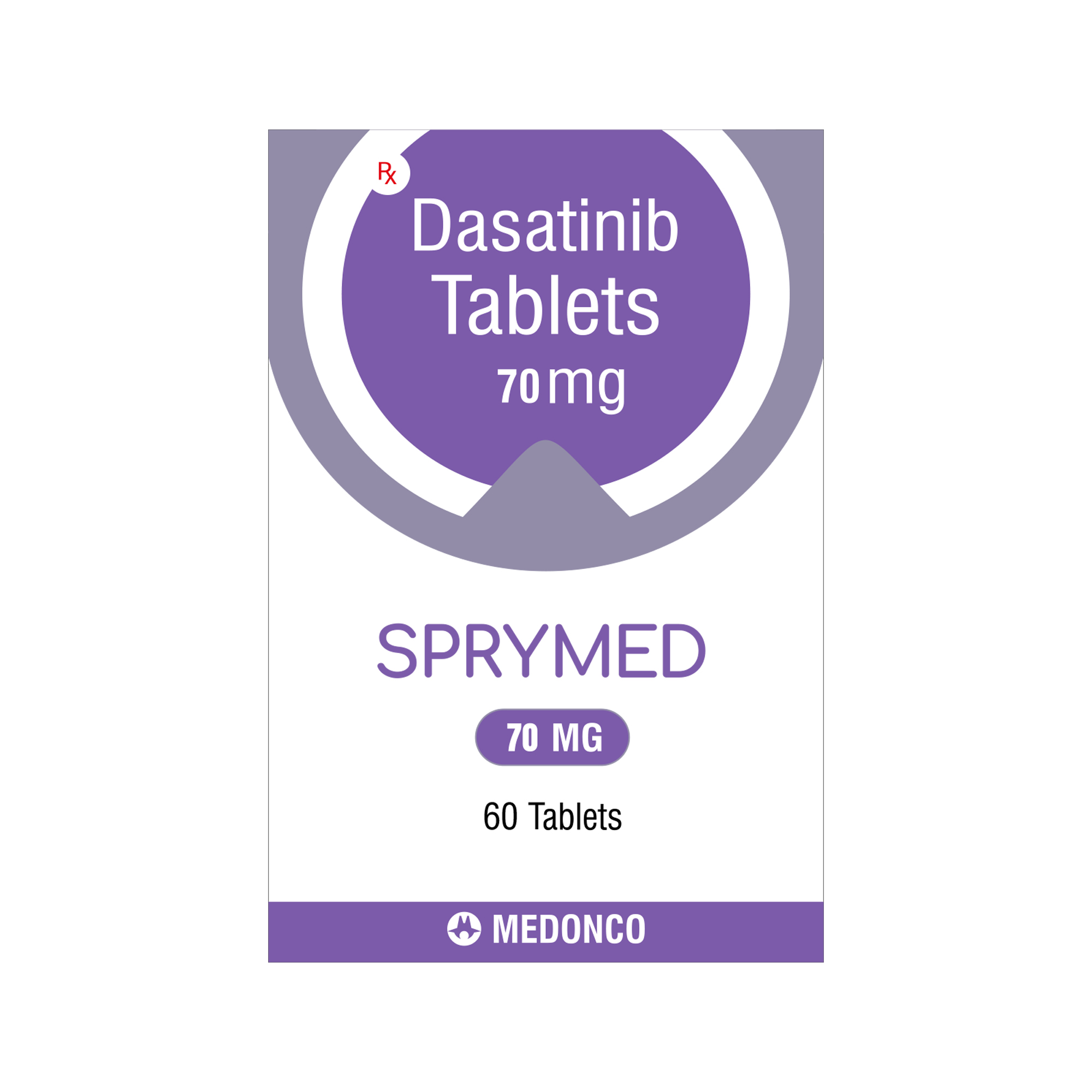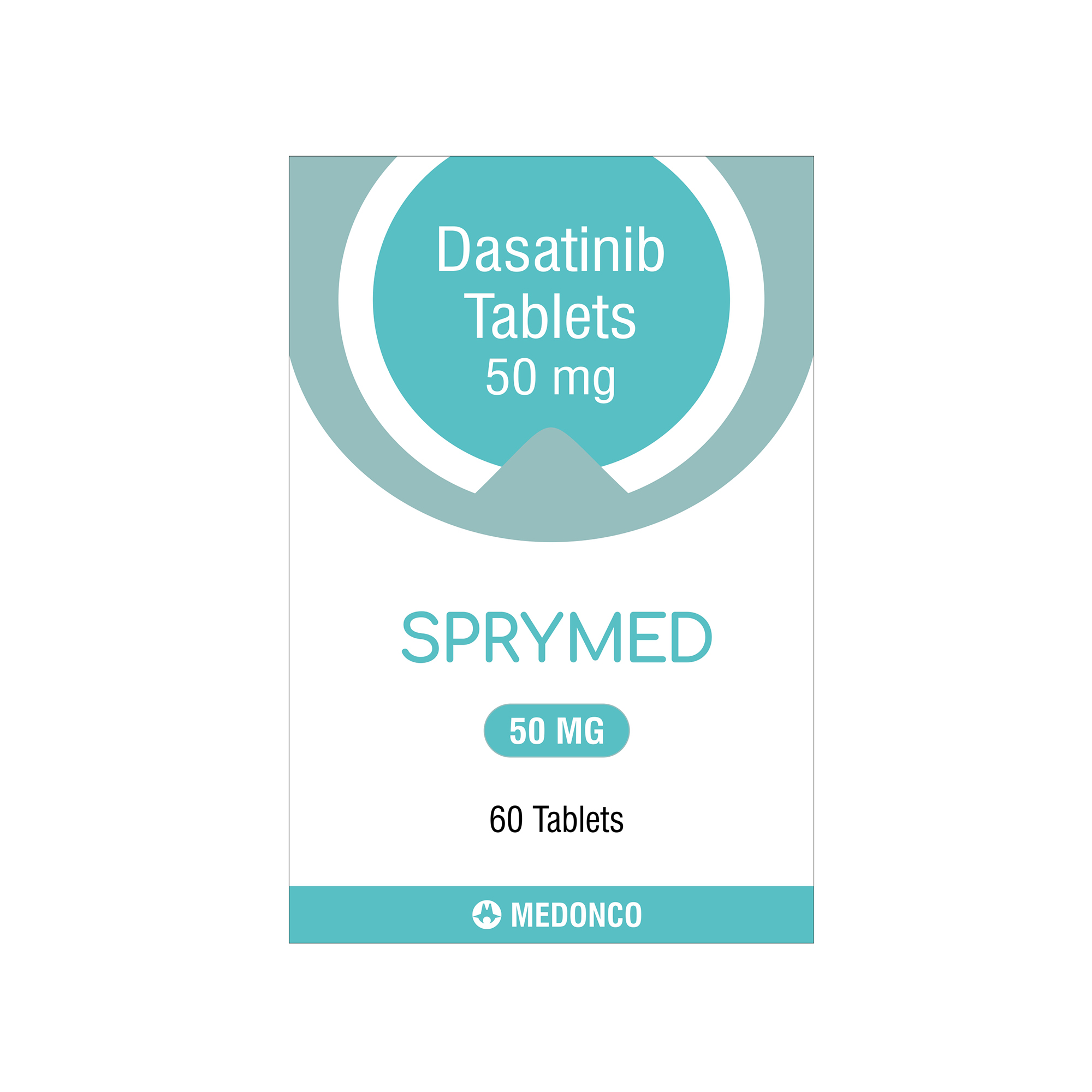

SPRYMED
Dasatinib 50mg/Dasatinib 70mg
Net Qty- 60 Tablets
Shelf-Life- 2 Years
Sprymed (Dasatinib) is a tyrosine kinase inhibitor (TKI) used for the treatment of specific types of leukemia.
USE
- Chronic Myeloid Leukemia (CML): Used for newly diagnosed cases or for patients who are resistant or intolerant to other TKIs (like Imatinib).
- Acute Lymphoblastic Leukemia (ALL): Specifically for Philadelphia chromosome-positive (Ph+ ALL) cases.
Mechanism
of Action
Dasatinib blocks the BCR-ABL kinase, which is responsible for the uncontrolled growth of leukemia cells. It also inhibits other kinases, making it more potent than first-generation TKIs.
Dosage and Administration
- Typical dose for CML: 100mg once daily (but may vary based on response).
- For Ph+ ALL: 140mg daily (adjustments may be made).
- Can be taken with or without food, but should be swallowed whole.
Common Side Effects
- Low blood cell counts (anemia, neutropenia, thrombocytopenia)
- Fluid retention (pleural effusion, swelling)
- Nausea, diarrhea
- Fatigue
- Headache
Monitoring
If you’re taking Dasatinib 50mg, regular monitoring is essential to ensure safety and effectiveness. Below are the key tests and parameters that should be checked:
1. Blood Tests (Complete Blood Count – CBC)
✅ Frequency: Weekly for the first 2 months, then monthly
✅ Purpose:
- Check for low white blood cell (WBC) count (neutropenia)
- Detect low platelet levels (thrombocytopenia)
- Identify anemia (low RBC count)
2. Liver Function Tests (LFTs)
✅ Frequency: Every 4-6 weeks or as needed
✅ Purpose:
- Monitor for elevated liver enzymes (AST, ALT, bilirubin)
- Ensure no drug-induced liver damage
3. Kidney Function Tests
✅ Frequency: Every 3-6 months
✅ Purpose:
- Monitor creatinine and blood urea nitrogen (BUN) levels
- Check for kidney impairment
4. Electrolytes (Sodium, Potassium, Calcium, Magnesium, Phosphorus)
✅ Frequency: Every 4-6 weeks
✅ Purpose:
- Prevent electrolyte imbalances that may cause heart problems
5. ECG (Electrocardiogram)
✅ Frequency: Before starting treatment and periodically
✅ Purpose:
- Monitor for QT prolongation, which can lead to heart rhythm issues
6. Chest X-ray or Lung Function Tests
✅ Frequency: If symptoms develop
✅ Purpose:
- Detect pleural effusion (fluid in the lungs), a common side effect
7. Bone Marrow Examination (For CML patients)
✅ Frequency: Every 3-6 months
✅ Purpose:
- Assess response to treatment and check for disease progression
8. BCR-ABL1 Mutation Testing (If resistance is suspected)
✅ Frequency: If treatment is not working
✅ Purpose:
- Identify mutations that may cause resistance to Dasatinib
- Determine if a different TKI (like Ponatinib or Bosutinib) is needed
9. Pregnancy Test (For Women of Childbearing Age)
✅ Frequency: Before starting treatment and as needed
✅ Purpose:
- Dasatinib is harmful during pregnancy, so women must avoid pregnancy during treatment
Important Precautions During Monitoring:
❌ Avoid grapefruit juice, as it can increase Dasatinib levels
❌ Do not take with antacids or proton pump inhibitors (PPIs) (reduces drug absorption)
✔ Stay hydrated to prevent kidney-related side effects
Precautions
- Avoid grapefruit and antacids (as they can affect absorption).
- Not recommended in pregnancy or breastfeeding.
- Regular blood tests are required to monitor response and side effects.
Drug Interactions
Dasatinib interacts with various drugs, affecting its absorption, metabolism, and effectiveness. Below are the key drug interactions you should be aware of:
- Acid-Reducing Agents (Reduce Dasatinib Absorption) – AVOID
- Proton Pump Inhibitors (PPIs): Omeprazole, Pantoprazole, Esomeprazole
- H2 Blockers: Ranitidine, Famotidine
- Antacids: Aluminum hydroxide, Magnesium hydroxide
✅ Solution: If an antacid is needed, take it 2 hours before or after Dasatinib.
- CYP3A4 Inhibitors (Increase Dasatinib Levels – Risk of Toxicity) – AVOID
- Antifungals: Ketoconazole, Itraconazole, Voriconazole
- Antibiotics: Clarithromycin, Erythromycin
- HIV Medications: Ritonavir, Indinavir, Saquinavir
✅ Solution: Dose adjustment may be required if these drugs must be used.
- CYP3A4 Inducers (Reduce Dasatinib Effect – Risk of Treatment Failure) – AVOID
- Anticonvulsants: Phenytoin, Carbamazepine, Phenobarbital
- Tuberculosis Drugs: Rifampin, Rifabutin
- Herbal Products: St. John’s Wort
✅ Solution: Consider alternative medications that do not induce CYP3A4.
- Blood Thinners & Antiplatelets (Increase Bleeding Risk) – CAUTION
- Warfarin, Heparin
- Aspirin, Clopidogrel
- NSAIDs (Ibuprofen, Naproxen, Diclofenac)
✅ Solution: Monitor for bleeding signs; use acetaminophen (paracetamol) as a safer option for pain relief.
- Cardiovascular Drugs (May Increase Heart Side Effects) – CAUTION
- QT-Prolonging Drugs: Amiodarone, Sotalol, Moxifloxacin
- Calcium Channel Blockers: Diltiazem, Verapamil (also CYP3A4 inhibitors)
✅ Solution: ECG monitoring may be needed if taken together.
- Immunosuppressants (Increase Risk of Infection) – CAUTION
- Tacrolimus, Cyclosporine
✅ Solution: Monitor immune function closely.
- Other Cancer Drugs (Possible Increased Toxicity) – CAUTION
- Other Tyrosine Kinase Inhibitors: Imatinib, Nilotinib, Bosutinib
- Chemotherapy Agents: Doxorubicin, Cyclophosphamide
✅ Solution: Careful dose adjustments and monitoring are required.
Clinical Effectiveness
Clinical Effectiveness of Dasatinib (50mg & Other Doses)
Dasatinib is a second-generation tyrosine kinase inhibitor (TKI), widely used for treating Philadelphia chromosome-positive (Ph+) leukemia. Clinical trials and real-world data show strong effectiveness in chronic myeloid leukemia (CML) and acute lymphoblastic leukemia (ALL), especially in patients resistant to Imatinib (first-generation TKI).
1. Effectiveness in Chronic Myeloid Leukemia (CML)
✓ First-line Treatment (Newly Diagnosed Patients)
- DASISION Trial (Dasatinib vs. Imatinib, 2010)
- At 12 months, 77% of patients achieved a major molecular response (MMR) with Dasatinib vs. 66% with Imatinib.
- Complete cytogenetic response (CCyR) was faster in Dasatinib users.
- Long-term follow-ups show high survival rates (~85–90%) over 5+ years.
✅ Conclusion: Dasatinib is more effective than Imatinib in newly diagnosed CML patients and provides faster and deeper molecular responses.
✓ Treatment for Resistant or Intolerant CML (Second-Line Therapy)
- START-C Trial (Dasatinib in Imatinib-Resistant Patients)
- 50% of patients who failed Imatinib achieved CCyR with Dasatinib.
- Effective against Imatinib-resistant mutations (except T315I mutation).
✅ Conclusion: Dasatinib rescues patients who fail Imatinib, significantly improving outcomes.
2. Effectiveness in Acute Lymphoblastic Leukemia (Ph+ ALL)
- GRAAPH-2005 Trial
- Dasatinib + Chemotherapy resulted in a higher complete remission rate (96% vs. 88% with Imatinib).
- Survival rates were better with Dasatinib, with a lower relapse rate.
✅ Conclusion: Dasatinib is superior to Imatinib for Ph+ ALL, offering better remission and survival rates.
3. Effectiveness in Pediatric Patients
- Dasatinib is approved for pediatric CML and Ph+ ALL and has shown similar benefits as in adults with acceptable side effects.
Tips for Patients
If you are taking Dasatinib, following these tips can help maximize benefits and minimize side effects:
1. How to Take Dasatinib Properly
✔ Take the tablet whole – do not crush, break, or chew.
✔ Can be taken with or without food (but take it the same way daily).
✔ Avoid grapefruit juice, as it increases drug levels and side effects.
✔ If you miss a dose, skip it and take the next dose as scheduled (do not double the dose).
2. Managing Side Effects
✅ Low Blood Cell Counts (Anemia, Neutropenia, Thrombocytopenia)
- Have regular blood tests to monitor counts.
- Report unusual bruising, bleeding, or infections immediately.
✅ Fluid Retention (Pleural Effusion, Swelling)
- Watch for swelling, shortness of breath, or cough.
- Limit salt intake and stay hydrated.
✅ Gastrointestinal Issues (Nausea, Diarrhea, Constipation)
- Eat small, frequent meals.
- Drink plenty of fluids.
- Take an anti-nausea medication if prescribed.
✅ Skin Issues (Rash, Dry Skin)
- Use moisturizers and wear sunscreen.
- If rash worsens, consult your doctor.
✅ Muscle & Joint Pain
- Light exercise and hydration can help.
- Painkillers like paracetamol can be used (avoid NSAIDs like ibuprofen without medical advice).
3. Lifestyle Tips
✔ Avoid smoking and alcohol, as they can interfere with treatment.
✔ Stay active but avoid overexertion if feeling fatigued.
✔ Practice good oral hygiene to prevent infections.
✔ Use contraception if needed – Dasatinib can harm unborn babies.
4. Regular Monitoring is Key
📌 Blood tests (CBC, liver, and kidney function)
📌 ECG (for heart monitoring)
📌 Chest X-ray (to check for lung fluid buildup)
5. When to Call Your Doctor 🚨
❌ Severe bleeding or unexplained bruises
❌ Breathing problems or swelling
❌ Persistent fever or infections
❌ Chest pain or irregular heartbeat